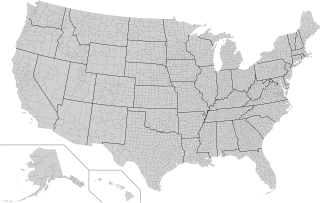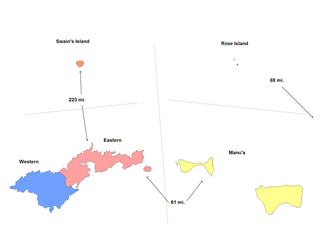Table
| State federal district or territory | Largest county parish or municipality [note 1] | Population (2013 estimate) [3] | County parish seat or shire town | State federal district or territory population (2013 estimate) [4] [note 2] | Largest county/parish or municipality Percentage of state/federal district or territory population |
|---|---|---|---|---|---|
| Jefferson | 659,479 | Birmingham | 4,833,722 | 13.64% | |
| Anchorage | 300,950 | Anchorage | 735,132 | 40.94% | |
| Western District [1] [note 3] | 31,329 [5] | — | 55,519 | 56.42% | |
| Maricopa | 4,009,412 | Phoenix | 6,626,624 | 60.50% | |
| Pulaski | 391,284 | Little Rock | 2,959,373 | 13.22% | |
| Los Angeles | 10,017,068 | Los Angeles | 38,332,521 | 26.13% | |
| El Paso | 655,044 | Colorado Springs | 5,268,367 | 12.43% | |
| Fairfield | 939,904 | Bridgeport | 3,596,080 | 26.14% | |
| New Castle | 549,684 | Wilmington | 925,749 | 59.38% | |
| District of Columbia | 693,972 | District of Columbia | 693,972 | 100% | |
| Miami-Dade | 2,617,176 | Miami | 19,552,860 | 13.39% | |
| | Fulton | 1,010,562 | Atlanta | 10,214,860 | 9.85% |
| Guam [note 4] | 162,742 | Hagåtña | 162,742 | 100% | |
| Honolulu | 983,429 | Honolulu | 1,404,054 | 70.04% | |
| Ada | 416,464 | Boise | 1,612,136 | 25.83% | |
| Cook | 5,240,700 | Chicago | 12,882,135 | 40.68% | |
| Marion | 928,281 | Indianapolis | 6,570,902 | 14.13% | |
| Polk | 451,677 | Des Moines | 3,090,416 | 14.62% | |
| Johnson | 566,933 | Olathe | 2,893,957 | 19.59% | |
| Jefferson | 756,832 | Louisville | 4,395,295 | 17.22% | |
| East Baton Rouge | 445,227 | Baton Rouge | 4,625,470 | 9.63% | |
| Cumberland | 285,456 | Portland | 1,328,302 | 21.49% | |
| Montgomery | 1,016,677 | Rockville | 5,928,814 | 17.15% | |
| Middlesex | 1,552,802 | Cambridge and Lowell | 6,692,824 | 23.20% | |
| Wayne | 1,775,273 | Detroit | 9,895,622 | 17.94% | |
| Hennepin | 1,198,778 | Minneapolis | 5,420,380 | 22.12% | |
| Hinds | 244,899 | Jackson | 2,991,207 | 8.19% | |
| St. Louis | 1,001,444 | Clayton | 6,044,171 | 16.57% | |
| Yellowstone | 154,162 | Billings | 1,015,165 | 15.19% | |
| Douglas | 531,265 | Omaha | 1,868,516 | 28.43% | |
| Clark | 2,027,868 | Las Vegas | 2,790,136 | 72.68% | |
| Hillsborough | 402,922 | Manchester and Nashua | 1,323,459 | 30.44% | |
| Bergen | 925,328 | Hackensack | 8,899,339 | 10.40% | |
| Bernalillo | 673,460 | Albuquerque | 2,085,287 | 32.30% | |
| | Kings | 2,592,149 | Brooklyn | 19,651,127 | 13.19% |
| Wake [6] | 990,977 | Raleigh | 9,848,060 | 10.06% | |
| Cass | 162,829 | Fargo | 723,393 | 22.51% | |
| Saipan [1] | 48,220 | Capitol Hill, Saipan | 52,263 | 92.26% | |
| Franklin [7] | 1,268,154 | Columbus | 11,570,808 | 10.96% | |
| Oklahoma | 755,245 | Oklahoma City | 3,850,568 | 19.61% | |
| Multnomah | 759,256 | Portland | 3,930,065 | 19.32% | |
| Philadelphia | 1,553,165 | Philadelphia | 12,773,801 | 12.16% | |
| San Juan [1] | 395,326 | San Juan | 3,337,177 | 11.84% | |
| Providence | 628,323 | Providence | 1,051,511 | 59.75% | |
| Greenville | 474,266 | Greenville | 4,774,839 | 9.93% | |
| Minnehaha | 179,640 | Sioux Falls | 844,877 | 21.26% | |
| Shelby | 940,764 | Memphis | 6,495,978 | 14.48% | |
| Harris | 4,336,853 | Houston | 26,448,193 | 16.40% | |
| | Wake Island | (100) [note 5] | (none) | (160) | 62.5% |
| Salt Lake | 1,063,842 | Salt Lake City | 2,900,872 | 36.67% | |
| Chittenden | 158,504 | Burlington | 626,630 | 25.29% | |
| | Saint Thomas island [1] | 51,634 | — [note 6] | 104,901 | 49.22% |
| Fairfax | 1,116,897 | Fairfax | 8,260,405 | 13.52% | |
| | King | 2,044,449 | Seattle | 6,971,406 | 29.33% |
| Kanawha | 191,275 | Charleston | 1,854,304 | 10.32% | |
| Milwaukee | 956,023 | Milwaukee | 5,742,713 | 16.65% | |
| Laramie | 95,809 | Cheyenne | 582,658 | 16.44% |







